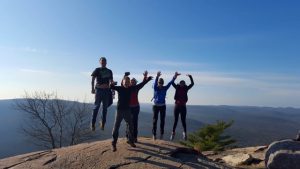
Get Hooked on Hiking
by Ira Sussman and Laura Carpentier, Experience Nyack
Looking to experience the thrill of a hike but unsure where to start? Don’t know what to bring? Afraid you will get lost? Worried that you’re not in shape?
There are things experienced hikers learn by trial and error (yes, we have made some errors, too).
Here are a few tips we can offer based on our experience hiking in Nyack, Rockland County, the Catskills and the Capital Region of New York State.
(And for your first hike, let Experience Nyack be your guide!)
1. Prepare For Your First Hike
When you first hit the trails it might seem like a “walk in the park” but over time you’ll realize preparation, knowledge and some key equipment make hiking safer and more enjoyable.
Good prep leads to longer and more challenging hikes as you become more experienced. You will want to plan your route, make sure you have good footwear, check the weather and bring plenty of water and snacks, too.
2. Finding Your Way
 Nyack Beach State Park offers a beautiful three mile, flat trail along the Hudson River. You might find yourself calling it one of your favorite hikes, even after you get more experience.
Nyack Beach State Park offers a beautiful three mile, flat trail along the Hudson River. You might find yourself calling it one of your favorite hikes, even after you get more experience.
It’s also just below Hook Mountain, another great local destination. Both hikes provide great views of the river and Westchester County from the left bank of the Hudson.
Before you go, review the trail, understand the elevation and the terrain, and make a mental note of where you are should you need to call for any help.
All registered trails also have colored markers to show you where to go called “blazes.” Each trail has a different colored marker so you know where to go, where to turn, and which trail to remain on if another trail crosses over.
 Trails are also rated based on how hard they are to navigate. Start with something relatively short and aligned to your abilities. Study your map and trail guide beforehand so you know where you are going and choose a hike that works for all the members of your group. You don’t want to have to stop halfway down the trail because one person cannot make it.
Trails are also rated based on how hard they are to navigate. Start with something relatively short and aligned to your abilities. Study your map and trail guide beforehand so you know where you are going and choose a hike that works for all the members of your group. You don’t want to have to stop halfway down the trail because one person cannot make it.
It’s good to tell someone where you’re going to be hiking in case something happens. You may have your cell phone with you but cell service and batteries can’t be counted on when on the trail.
You can download a smartphone mapping app like Avenza.com which can show you where you are on the trail. When hiking, you should take a tip from the Boy Scouts and “be prepared,” That way you won’t have to worry and can enjoy the trek even more.
3. Three Types of Hikes

- Where do you start and often end your hike? That location is called the trailhead.
- In & out hikes take you down the trail…then return on the same path.
- A trail that returns to the starting point without doubling back where you have already walked is called a loop.
Bonus: what do you get when you combine a loop and an in & out? Lollipops! These hikes have the same entrance and exit but add a loop somewhere along the way.
For beginners, simple loops offer the most enjoyment and don’t require much planning.
A popular Rockland County hike is the Long Path, a route that starts in NYC near the George Washington Bridge and then goes north and ends near Albany. Longer trails like this can be hiked in segments. When hiking a segment of a long one-way trail you can even plan ahead, use two cars and drop one car at the end of your planned hike to take you back to the trailhead where you started.
4. Hike Prep
Forgetting simple things like rain gear, snacks, or a fresh pair of socks can ruin a day’s hike. Being caught unprepared on a mountaintop can have serious consequences. If you have just these few items you will be prepared for your day hike.
5. Shoes
The right shoes can make all the difference between great hikes and great agony. While sneakers are comfortable on flat terrain, they can be dangerous when hiking on uneven trails; you need added support and tread to keep from slipping and twisting an ankle. Pick a light, flexible shoe with ankle support. Once you’re hooked and want to start hiking more advanced trails, you can upgrade to a trail shoe or lightweight hiking boot with a better tread.
6. Staying Hydrated
Water is essential for life. Hiking can help you get the most out of life! Therefore, make sure you bring plenty of water.
Two to three liters of water for an all day hike is generally a good amount, but if you are hiking in a hot, dry climate with a lot of elevation gain, you may need more. Drinking a lot of water on the days preceding a long hike will help keep you hydrated longer. If you find yourself out on a hot day without enough water, often you’ll feel yourself getting tired, and it can be attributed to dehydration, rather than fatigue.
7. Clothing
You always need to consider the weather. The day may start out chilly, but you will start to warm up as you hike and the day progresses. If you are hiking in the mountains, the weather can change rapidly if the sun is blocked or when you approach sunset: temperatures can drop by as much as 40 degrees in just a few hours.
You want to avoid being too cold, too hot, or wet should it rain. Dress in layers and carry rain gear so you can adjust to changes in temperature as needed. Also wear synthetic materials, which wick water away from your skin instead of cotton which retains sweat and moisture. Wear long pants when possible to protect against ticks.
8. Walking Sticks
Don’t assume that older people who use walking sticks need them because they can’t balance. Maybe they just have more experience at hiking than you do!
Did you ever notice four-legged animals can run around on all terrains without ever tripping or falling? There’s a reason for that — having an extra “leg” to brace yourself on uneven terrain can keep you from sliding down hillsides and keep you upright when a root tries to reach out and trip you.
9. Snacks
Depending on how far you are hiking, you will likely want to refuel. While fruit and sandwiches and bottles of drinks are great for a picnic, the more you stash in a backpack, the harder it is to hike. Opt for non-perishable foods that are relatively lightweight and nutrient-dense, such as trail mix, nuts, seeds, nut-based bars, dried or freeze-dried fruits and veggies, energy or granola bars.
10. What Else?
Pack insect repellent and sunscreen. Pack a First Aid kit. Can’t hurt to have a flashlight too, even if you start early in the day. Carry all of these “be prepared” necessities in a lightweight backpack.
Ira Sussman and Laura Carpentier are the co-founders of Experience Nyack, a locally based tourism company creating and delivering fun, educational & entertaining experiences like historic walking tours, guided day hikes of Hook Mountain and other destinations, as well as other outdoor activities. Visit Experience Nyack online to explore their offerings and book a tour.
Experience Nyack
experiencienyack.com
info@experiencenyack.com
347-868-7397




